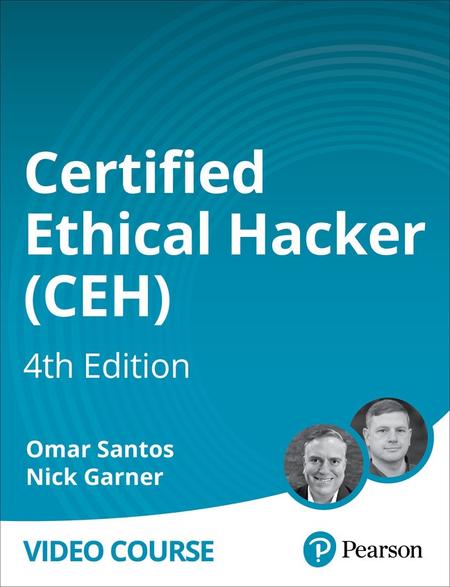English | MP4 | AVC 1280×720 | AAC 44KHz 2ch | 12h 4m | 3.06 GB
Prepare for the Certified Ethical Hacker (CEH) certification exam.
- Get exam topics and skills to successfully prepare for the Certified Ethical Hacker (CEH) certification exam
- Step-by-step examples of security penetration testing methodologies and concepts
- Sample questions for each of the topics covered in the exam
Certified Ethical Hacker (CEH), 4th Edition gives a complete overview of the topics in the EC-Councils updated Certified Ethical Hacker (CEH) exam. This video course has seven modules that dive into the key objectives of the exam, providing an in-depth exploration of ethical hacking, including fundamentals; reconnaissance techniques; network and perimeter hacking; System Hacking Phases and Attack Techniques; web application hacking; wireless, mobile, IoT and OT hacking; cloud computing, and cryptography. Taught by experienced security experts Omar Santos and Nick Garner, this full-featured video course will help learners better understand the world of hacking so they can act to defend attacks, as well as pass the CEH exam.
Table of Contents
Introduction
1 Certified Ethical Hacker (CEH) Introduction
2 Certified Ethical Hacker (CEH) Introduction
Lesson 1 Introduction to Ethical Hacking
3 Learning objectives
4 Introducing Information Security and Cybersecurity
5 Understanding the Cyber Kill Chain and Hacking Concepts
6 Surveying Ethical Hacking Methodologies
7 Undertanding Information Security Controls
8 Understanding Security Laws and Standards
9 Planning and Scoping a Penetration Testing Assessment
10 Building Your Own Hacking Lab with WebSploit Labs
Lesson 2 Footprinting and Reconnaissance
11 Learning objectives
12 Understanding Information Gathering and Vulnerability Identification
13 Introducing Open Source Intelligence (OSINT) Techniques
14 Exploring Footprinting Methodologies
15 Utilizing Search Engines for Footprinting
16 Footprinting Web Services
17 Exploiting Social Networking Sites for Footprinting
18 Surveying Password Dumps, File Metadata, and Public Source-code Repositories
19 Implementing DNS Footprinting
20 Executing Network Footprinting
21 Applying Social Engineering for Footprinting
22 Introducing Shodan, Maltego, AMass, Recon-NG, and other Recon Tools
23 Identifying Cloud vs. Self-hosted Assets
Lesson 3 Scanning Networks
24 Learning objectives
25 Surveying Network Scanning Concepts
26 Exploiting Scanning Tools
27 Understanding Host Discovery
28 Performing Website and Web Application Reconnaissance
29 Performing OS Discovery (Banner GrabbingOS Fingerprinting)
30 Scanning Beyond IDS and Firewall
31 Creating Network Diagrams
32 Discovering Cloud Assets
33 Crafting Packets with Scapy to Perform Reconnaissance
Lesson 4 Enumeration
34 Learning objectives
35 Introducing Enumeration Techniques
36 Performing NetBIOS Enumeration
37 Performing SNMP Enumeration
38 Performing LDAP Enumeration
39 Performing NTP and NFS Enumeration
40 Performing SMTP and DNS Enumeration
41 Conducting Additional Enumeration Techniques
42 Surveying Enumeration Countermeasures
Lesson 5 Vulnerability Analysis
43 Learning objectives
44 Understanding Vulnerability Assessment Concepts
45 Classifying and Assessing Vulnerability Types
46 Utilizing Vulnerability Assessment Tools
47 Generating Vulnerability Assessment Reports
Lesson 6 System Hacking
48 Learning objectives
49 Understanding System Hacking Concepts
50 Gaining System Access
51 Cracking Passwords
52 Exploiting Known and Zero-Day Vulnerabilities
53 Escalating Privileges
54 Maintaining Access, Command and Control, and Exfiltration
55 Executing Applications
56 Hiding Files
57 Clearing Logs
58 Performing On-Path Attacks
59 Introduction to Lateral Movement and Exfiltration
60 Understanding Post-Engagement Cleanup
Lesson 7 Malware Threats
61 Learning objectives
62 Understanding Malware Concepts
63 Comprehending APT Concepts
64 Grasping Trojan Concepts
65 Exploring Virus and Worm Concepts
66 Examining Fileless Malware and Living off the Land Techniques
67 Analyzing Malware
68 Implementing Malware Countermeasures
Lesson 8 Sniffing
69 Learning objectives
70 Introducing Sniffing Concepts
71 Performing MAC Attacks
72 Conducting DHCP Attacks
73 Performing ARP Poisoning
74 Performing Spoofing Attacks
75 Performing DNS Poisoning
76 Surveying Sniffing Tools
77 Exploring Sniffing Countermeasures and Detection Techniques
Lesson 9 Social Engineering
78 Learning objectives
79 Introducing Social Engineering Concepts and Techniques
80 Understanding the Insider Threat
81 Impersonation on Social Networking Sites
82 Understanding Identity Theft
83 Understanding Social Engineering Countermeasures
Lesson 10 Denial-of-Service
84 Learning objectives
85 Introducing DoSDDoS Concepts and Attack Techniques
86 Defining what are Botnets
87 Exploring DDoS Case Studies
88 Surveying DoSDDoS Attack Tools
89 Understanding DoSDDoS Countermeasures and Protection Tools
Lesson 11 Session Hijacking
90 Learning objectives
91 Introducing Session Hijacking Concepts
92 Performing Application Level Session Hijacking
93 Understanding Network Level Session Hijacking
94 Surveying Session Hijacking Tools
95 Understanding Session Hijacking Countermeasures
Lesson 12 Evading IDS, Firewalls, and Honeypots
96 Learning objectives
97 Introducing IDS, IPS, Firewall, and Honeypot Concepts
98 Exploring IDS, IPS, Firewall, and Honeypot Solutions
99 Evading IDS and Firewalls
100 Surveying IDSFirewall Evading Tools
101 Detecting Honeypots and Sandboxes
102 Understanding IDSFirewall Evasion Countermeasures
Lesson 13 Hacking Web Servers
103 Learning objectives
104 Introducing Web Server Concepts
105 Exploring Web Server Attacks
106 Surveying Web Server Attack Methodologies
107 Understanding Web Server Countermeasures
108 Understanding Patch Management
Lesson 14 Hacking Web Applications
109 Learning objectives
110 Understanding Web App Concepts and Identifying Web App Threats
111 Exploring the OWASP Top 10 for Web Applications
112 Applying Web App Hacking Methodologies and Footprinting Web Infrastructure
113 Analyzing Web Applications and Bypassing Client-Side Controls
114 Attacking Authentication Mechanisms
115 Attacking Session Management Mechanisms
116 Exploiting Authorization Schemes and Access Controls Flaws
117 Exploiting Cross-site Scripting (XSS) and Cross-site Request Forgery (CSRF) Vulnerabilities
118 Understanding Server-side Request Forgery (SSRF) Vulnerabilities
119 Exploiting Buffer Overflows and Creating Payloads
120 Attacking Application Logic Flaws and Shared Environments
121 Attacking Database Connectivity and Web App Clients
122 Attacking Web Services, Exploiting Web APIs, Webhooks, and Web Shells
123 Ensuring Web App Security
Lesson 15 SQL Injection
124 Learning objectives
125 Introducing SQL Injection Concepts
126 Understanding the Types of SQL Injection
127 Exploring the SQL Injection Methodologies
128 Exploring SQL Injection Tools
129 Exploring SQL Injection Evasion Techniques
130 Understanding SQL Injection Countermeasures
Resolve the captcha to access the links!
